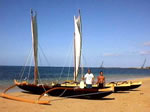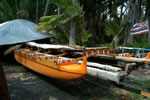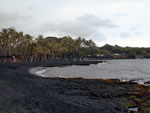Boatbuilding
How Captain Kiko built his wa’akaulua (double canoe):
In 1926 Waikiki beach boy A.E. (Toots) Minnville commissioned the carving of a wa’akaukahi (surfing outrigger canoe) at Honaunau in the district of south Kona for taking visitors surfing at Waikiki. By the early 1950’s the koa trees for making dugout canoes were scarce and the existing canoes were too valuable to risk in the rough and tumble of daily surfing. A mold was made about 1953 from the Minnville canoe and a number of replicas were built.
Captain Kiko found one of these replicas on the back lawn of a hotel where it had a piece of plywood nailed on top of it to transform it into a bar for the hotel’s tourist luau. He tried to buy it but they wouldn’t part with it. He then found another one sitting on the beach at Keauhou Bay rigged as a single outrigger paddling canoe. This canoe named Wahine Akala (pink lady) was now owned by Joe Long.
Wahine Akala was once owned by Louis Kahanamoku, brother of noted Hawaiian surfer Duke Kahanamoku. She had been used to take guests surfing in front of the Royal Hawaiian Hotel, the Pink Lady of Waikiki. When he retired to Kona he brought Wahine Akala with him and she was used to start the modern Kai Opua Canoe Racing Club and later Kauikeaouli (Keauhou Canoe Club). Mr. Kahanamoku sold her to Joe Long, one of the founders of Save Our Surf. When Joe Long was ready to sell her, Captain Kiko and Joe Long got Louis Kahanamoku’s blessing and in 1987 she became his first traditional single outrigger Hawaiian canoe.
Wahine Akala was used for surfing as a single canoe and rigged with a sail. She was raced from Wai’anae, Oahu to Wiliwili, Kaua’i for a distance of 83 nautical miles in the 1988 Na Holo Kai sailing canoe race. She was sailed to Oahu by being rigged as the longer of the two hulls of a wa’a kue’e (double canoe with unequal hull sizes).
Now Captain Kiko was searching for a second 28-foot canoe to use with Wahine Akala to make a wa’akaulua (double canoe). For awhile he used a 32-foot canoe. In 1991 he purchased a matching 28-foot canoe named Keoni Nakai from Iver (Little Joe) Kaipo. Little Joe had used her to take people surfing at Kaele Huluhulu at Mahai’ula, north Kona, the site of today’s Kekaha Kai State Park. She was rigged and sailed as a makeshift double canoe and then in October 1992 after an extensive rebuild was launched as a full-time wa’akaulua (double canoe).








